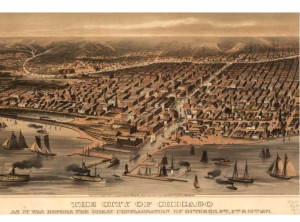Although cargo carrying sailing ships crossed oceans for thousands of years, their time on the treacherous waters of Lake Michigan was much more limited. They faced competition from faster and more reliable birchbark canoes in their early days. As soon as canoes went out of fashion, faster and more reliable steamships began traveling the Lake.
In their heyday almost all sailing ships on Lake Michigan were wooden centerboard schooners. A schooner is defined as decked sailing vessel with a least two masts and a fore and aft rig (as opposed to a square rigger) The fore and aft rig could be managed with a smaller crew and was much more useful in the variable winds of the Great Lakes.
Centerboards are a type of droppable keel that allowed the schooners to cross the shallow sandbars of most Lake Michigan ports. The schooners tended to be small, less than 200 feet long and a few hundred tons.
Timeline (based on Schooner Passage and From Lumber Hookers to the Hooligan Fleet)
- 1679: LaSalle builds a small ship called the Griffon. She sails to Green Bay from Lake Erie. On the return voyage she disappears with her crew and valuable cargo of furs. For the next hundred years Lake Michigan saw only the more dependable canoes and bateaux (small French fur trade boats which could be rowed or sailed downwind.)
- 1778: A British fur trader begins sending small ships from Mackinac to Green Bay and Milwaukee. Most traders continued to use birchbark canoes, but some traders and the British, and later American governments, built a small number of ships. The Fort Dearborn garrison was supplied by American schooners. The American Revolution and the War of 1812 brought a naval arms race to the Great Lakes with each side building more and larger ships.
- 1818: Walk on the Water, the first steamship on the upper Great Lakes, is launched on Lake Erie.
- 1833: The Town of Chicago is incorporated. Birchbark canoes, small sailing ships and steam vessels are all in use on Lake Michigan. Steamships take over the passenger business on the Lakes. Sailing ships soon are useful only to carry bulk cargoes such as lumber, grain and coal. Aside from Green Bay, the only harbors on Lake Michigan are small rivers blocked by sandbars at the mouth.
- 1835-1839: Chicago successfully politics the federal government to build a harbor.
- 1855: Schooner traffic on the Lake and into Chicago has increased tremendously. The schooner barge is invented. Wooden ships could only be built about 300 feet long, whereas steam engines were powerful enough to drive much larger ships. A schooner barge is an old schooner with the deck and top masts removed. A steamship could tow five or six barges. Each barge had a small crew and raised sails to help out if the wind was favorable.
- 1868: Chicago earns the title of the busiest port in the world with over 100 daily ship clearances-mostly schooners. Steamships dominate the passenger and package business. However there were miles of lumber yards along the South Branch of the River supplied by schooners from the forests near Lake Michigan. Lumber was transshipped to the Illinois & Michigan Canal and to Chicago’s many railroads for use on the treeless prairie. Coal was another major commodity. The mouth of the river was lined with grain elevators. The largest outgoing cargo was grain carried in schooners.
- 1880s: Steel steamships of 300 feet and up are built. Schooners find it difficult to compete and the last of the lake schooners are built. Already many schooners had been converted to schooner barges dragged behind steamships. Since barges were wet and prone to sink, they were best suited for lumber cargoes. After 1900 even this use dropped off as nearby forests are cut down.
- 1930: The last commercial voyage of a Lake Michigan schooner. Sailing ships lasted longer on the oceans. Commercial ocean-going sailing ships would continue to be built into the 1930s. A few square rigged ships continued in ocean-going cargo service until the end of World War II.
For more information see the booklist.




Add a comment to: Schooners: Technology That Changed Chicago